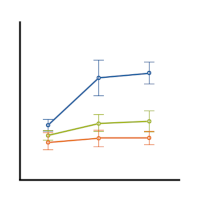One of the biggest challenges in learning statistics and data analysis is learning the lingo. It doesn’t help that half of the notation is in Greek (literally).
The terminology in statistics is particularly confusing because often the same word or symbol is used to mean completely different concepts.
I know it feels that way, but it really isn’t a master plot by statisticians to keep researchers feeling ignorant.
Really.
It’s just that a lot of the methods in statistics were created by statisticians working in different fields–economics, psychology, medicine, and yes, straight statistics. Certain fields often have specific types of data that come up a lot and that require specific statistical methodologies to analyze.
Economics needs time series, psychology needs factor analysis. Et cetera, et cetera.
But separate fields developing statistics in isolation has some ugly effects.
Sometimes different fields develop the same technique, but use different names or notation.
Other times different fields use the same name or notation on different techniques they developed.
And of course, there are those terms with slightly different names, often used in similar contexts, but with different meanings. These are never used interchangeably, but they’re easy to confuse if you don’t use this stuff every day.
And sometimes, there are different terms for subtly different concepts, but people use them interchangeably. (I am guilty of this myself). It’s not a big deal if you understand those subtle differences. But if you don’t, it’s a mess.
And it’s not just fields–it’s software, too.
SPSS uses different names for the exact same thing in different procedures. In GLM, a continuous independent variable is called a Covariate. In Regression, it’s called an Independent Variable.
Likewise, SAS has a Repeated statement in its GLM, Genmod, and Mixed procedures. They all get at the same concept there (repeated measures), but they deal with it in drastically different ways.
So once the fields come together and realize they’re all doing the same thing, people in different fields or using different software procedures, are already used to using their terminology. So we’re stuck with different versions of the same word or method.
So anyway, I am beginning a series of blog posts to help clear this up. Hopefully it will be a good reference you can come back to when you get stuck.
We’ve expanded on this list with a member training, if you’re interested.
If you have good examples, please post them in the comments. I’ll do my best to clear things up.
Why Statistics Terminology is Especially Confusing
Confusing Statistical Term #1: Independent Variable
Confusing Statistical Terms #2: Alpha and Beta
Confusing Statistical Term #3: Levels
Confusing Statistical Terms #4: Hierarchical Regression vs. Hierarchical Model
Confusing Statistical Term #5: Covariate
Confusing Statistical Term #6: Factor
Same Statistical Models, Different (and Confusing) Output Terms
Confusing Statistical Term #7: GLM
Confusing Statistical Term #8: Odds
Confusing Statistical Term #9: Multiple Regression Model and Multivariate Regression Model
Confusing Statistical Term #10: Mixed and Multilevel Models
Confusing Statistical Terms #11: Confounder
Six terms that mean something different statistically and colloquially
Confusing Statistical Term #13: MAR and MCAR Missing Data


